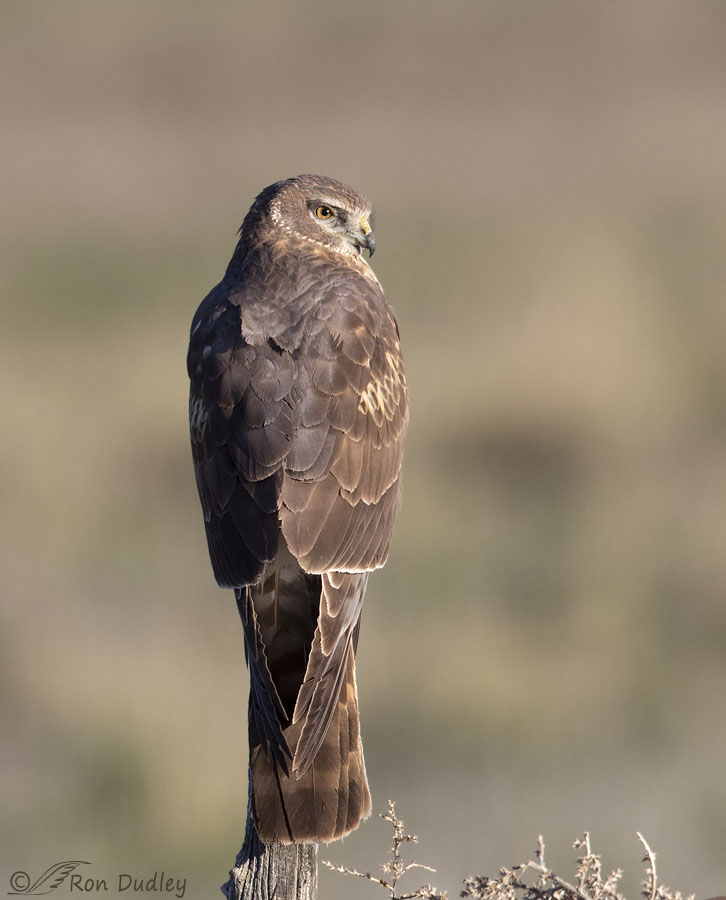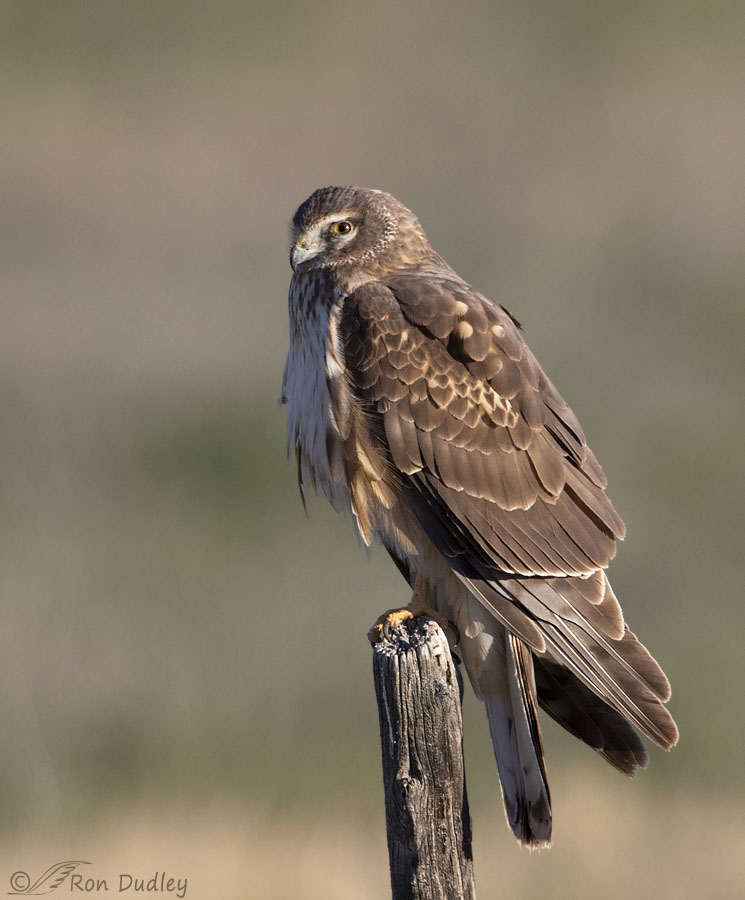Without question this is the “tamest” Northern Harrier I’ve ever photographed and I’ve had thousands of them in my viewfinder over the years.
I don’t post perched harriers often. They’re always shy but in my experience they’re even more difficult to get close to while perched than they are in flight. As a result I have far more harrier flight shots than I do photos of them perched.

1/2500, f/6.3, ISO 800, Canon 7D Mark II, Canon EF 500mm f/4L IS II USM, not baited, set up or called in
But this first spring male Northern Harrier from four years ago was a notable exception. For weeks during April and May that year I would reliably find him perched on the same fence posts next to a rural road and he typically wouldn’t fly off even when I had to drive by within 15′ of him – extremely unusual behavior for a harrier.
The first time it happened I remember wondering if he was sick or injured but he was just fine. He would take off and hunt on the wing normally whenever he felt the urge.
For this photo I was so close I wasn’t even using my teleconverter while shooting vertically. That almost never happens with perched harriers.

1/2000, f/6.3, ISO 640, Canon 7D Mark II, Canon EF 500mm f/4L IS II USM + EF 1.4 III Extender, not baited, set up or called in
This photo of the same bird on an adjacent fence post was taken two minutes after the previous one. This bird simply did not care that I was there and as close as I was.
I dunno, maybe he thought he was a House Sparrow or a robin instead of a harrier.
Ron.


Wow! Nice going Ron.The good life.
Thanks, Dave.
NOHAs take my breath away, in person and in photos, they’re so … fierce-looking and beautiful, all at once. And this fine young fella is no exception, although I’m sure by now he’s developed that fiercer part of his nature. I’m going to assume he is still on the wing and waiting for his next photo opp! 😉
“I’m going to assume he is still on the wing and waiting for his next photo opp! ”
Wouldn’t that be fun. If I can only get out there again…
WOW!!!
Thanks, Patty.
Lucky you. Such a handsome bird.
Yup, lucky me.
What a majestic AND co-operative bird. And a clear explanation for where the phrase ‘eagle-eyed’ originated.
Many thanks to you both.
Thanks, EC. Most credit goes to my subject.
Not so but far otherwise. Yes, the harrier would still have been majestic and marvellous, but without you, people all over the world would have been deprived of that majestic marvel.
Such a grand fellow! So glad you had this opportunity and equally glad you’ve shared it with us. I could look at this bird for hours!
Just looking at his eye, the first shot seems to have a coy, come hither look and the second shot says, “Woah! Too close!” (I have to entertain myself somehow these days.)
I think we’re all getting pretty creative in our entertainment. Thanks, Marty.
This is stunning! I absolutely love the first photo! The pose, with the turn of the head, the light on one side.
Thanks, April. I can’t get over how long the bird is in that first shot.
The disk of feathers around his face in the first photo makes him look wise to me. That’s probably because of our cultural association with owls and wisdom due to Athena.
Could be…
Glad you two found each other. A gorgeous bird in perfect poses and a photographer up to the task of of capturing them. Thanks. To the both of you.
Thank you, Lyle.
Ron, you are very fortunate to have seen so many. I have a piece of land in Central WA that is at about 4k elevation and three years ago I had the pleasure of hosting one during the spring and summer. He was cast with many of the grey tones, but unfortunately I never got a picture. That summer is the only time I’ve been lucky enough to identify a Northern Harrier. He was a real beauty to watch hunt skimming over the grass the way they do.
David, yes I’m fortunate indeed to have photographed so many harriers. They’re common at Farmington Bay WMA especially in the winter and I’ve been photographing them there for about 13 years now. There have been some mornings when I’ve photographed a dozen or more harriers there (often poorly). I photograph them in other areas too. These photos were taken in extreme northern Utah (not Farmington).
Beautiful shots! The sharp eyes and soft backgrounds really make the photos excellent. I’m curious though about how you know it’s a male. The males that I’ve seen are gray or grayish with mostly white undersides. The females I’ve seen also have mostly white undersides and are streaked with brown on the underside but mostly brown on top. This non-white feathers on this bird look brown…although the back seems to have a grayish cast. Are there other features that help identify it as a male? Does the grayish cast on the back identify it as a male? I may have miss-identified some of my prior images. Thanks.
Steve, adult males like the ones you mention are easy to identify. They’re often called “Gray Ghosts” in part because of their gray tones. But the sexes look very similar in young birds like this one and to be honest I can’t sex them very accurately either at this age. A good friend whose ID skills are much better than mine identified this particular bird as a young male so I just went with it.
Thanks for the explanation. Yes, ‘Gray Ghosts’ is what I’ve identified as males. I didn’t realize the differences with immature males. It makes sense.
SO ELEGANT ! That dignity and grace is so classical–what a
“capture” for you, and I am so glad to be able to see it, too….
Kris, believe it or not four years later I still look for that bird when I pass that section of fence which I do often. A very memorable harrier.
Beautiful pictures. I’m not sure I would recognize a harrier if not in flight. That white patch is my signal.
Yup, their white rump patch is pretty distinctive and one of the key field marks while they’re in flight.
What a gorgeous bird😍 Love his expressions. His first one, yes I’m handsome so take your picture. Second one, come any closer I’m out here❗️
On a recent hike we came up on a photographer. We passed him slowly not wanting to disturb his subject. We were finally able to look it was a Red-tailed hawk that was so close it seemed to be posing for him. Would have love to see those pictures❗️
I’m glad you were as respectful as you were for both the photographer and the hawk, Diana. I’ve had folks honk as they drove by to deliberately spook the bird I was photographing. More than once.
When that happens I always wish an immediate flat tire for them. Hasn’t happened yet but I remain hopeful…
Nice shots Ron. That is very unusual behavior for a Northern Harrier. I have photographed them many times and the only time I ever got close to one was when she was feasting on a coot.
Yup, food will definitely make them more “sticky”.
Beautiful photographs! What more can I say? Thanks.
Thanks, Joanne.
Those two shots are so beautiful that they “took my breath away”. Yep. I was stunned by the first one, and realized by the second one that I was so mesmerized that I had forgotten to breathe. The second shot is better than any dramatically posed human portrait.
Thanks very much, Suzanne. It certainly helps to have a cooperative subject.
Gorgeous bird! Can’t believe he held still and pretty much ignored you! 🙂 Now wondering if that’s what zipped by me yesterday morning as the impression of the face was “owl” but too small for a GHO……. 😉
Could be, Judy. Harriers are pretty good in the “zipped” department…
This Harrier is simply amazing!! He is so handsome and how very fortunate you were that he accepted your presence. I love Northern Harriers. In all my years of rehabilitation I received only one, a beautiful female. Fortunately she recovered from her broken wing and was released. With their hooded eyes they look so stern and regal. Thank you for these wonderful photos. Stay healthy and safe. Hopefully your favorite sites will be open to you again soon.
Thank you, Melanie. Sadly I’m unlikely to be able to access most of those places anytime soon.
Wonderful photographs of this beautiful N. Harrier, Ron! I love the catch light on the eye and the artistic background. That must have been a heart-pounding moment, in a good way, when you first experienced her this close.
Thanks, Ed .What made it extra special was that it happened again and again during April and May that year. And it hasn’t happened since.
I see now this is a young male. Very nice!